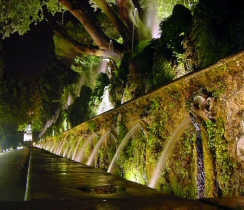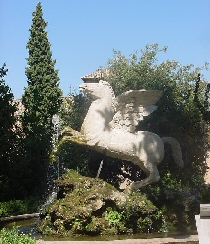Both the decorative elements of the garden (fountains, basins, etc) and the
painted decoration of the palace and the antique statues adorning the garden and palace illustrate these allegories and symbols, which complement each other to form a cohesive whole.
The plan of the villa is irregular because the architect was obliged to make use of certain parts of the previous monastic building. The present entrance at Piazza Trento (originally the secondary one because the main entrance
used to be at the bottom of the garden) leads to the central courtyard, the reconverted former cloister (1566– 67) embellished with the Fountain of Venus.
Among its contemporaries, the Villa d'Este soon became famous, thanks to its innovative plan, magnificence, rich decorations, and the extraordinary variety of its jeux
d'eau. The influence of the Villa d'Este was decisive for the development of the art of European gardens, and it remained an unrivalled model until the French garden of Versailles and Vaux-le-Vicomte came into fashion.
With the revival of formal gardens in the first decades of the 20th century, the Villa d'Este became once more a source of inspiration for architects and landscape designers, particularly British and Americans who had studied in Roman academies. Back in their own countries they put the principles they had learnt into practice.
The Villa d'Este is one of the most refined and complete examples of Italian Renaissance civilization.
It is most of all an unrivalled example of an 16th century Italian garden, representing, with its architectural works (palace, fountains, loggias, nymphaea, and grottoes) and precious decorations (such as the pictorial cycles painted by famous artists from the Roman Mannerist school, such as Federico Zuccari and Girolamo Muziano), one of the most fascinating accomplishments of Italian Renaissance architecture.
Besides bearing witness to the learning and refinement of its creator, today the Villa d'Este still represents an exceptional synthesis of the values of an epoch, combining elements ranging from architectural styles to the humanities, from science to antiquarian passion, from hydraulics to complex iconology.
Surroundings
-
The Sacro Speco

An impressive complex of buildings which almost looks as if it is one with the surrounding rock...
To know more
-
Rocca Pia
Built on the place where Callisto II Borgia's Castle was situated...
-
Church of St.Peter
It was built on the rests of a roman villa...
Tivoli's attractions

Patrocinio Comune di Tivoli
Assessorato al Turismo




